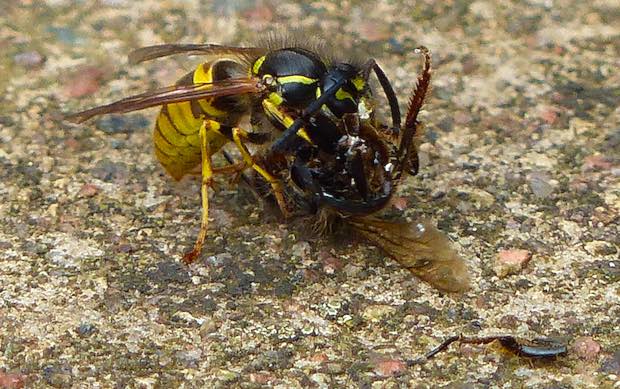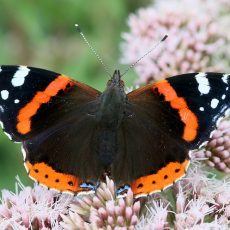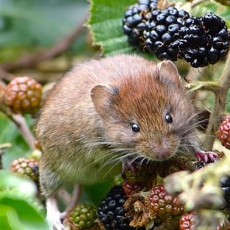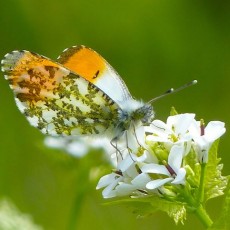It is unfortunate that wasps and hornets have a reputation of being insects to be feared. They are Nature’s beneficial natural pesticides, so should be welcome in our gardens. Having photographed and filmed them many times, I now love to meet these characterful insects.

Gardener’s friend
Adult wasps and hornets are unable to eat solid food (see Interesting facts about wasps below), they are only able to lap liquids such as nectar. But the larvae of wasps and hornets are fed on invertebrates. One hornet’s nest alone can have 900 workers and wasps produce 1,000’s of carnivorous larvae throughout the year.
They do a tremendous, non-polluting job: hornets mainly catch flies, some of which are regarded as agricultural pests, and wasps catch many insects and caterpillar pests around the garden. Far better than using indiscriminate, harmful pesticides. Wasps will take honey bees from time to time, but tend to be opportunistic, generalist predators so are not a problem to bee keepers. Hornets will also take the odd honey bee, but in general they are no threat to a hive.
Gentle giants
Hornets are noticeably bigger than wasps but despite their alarming size, away from the nest they are not aggressive and will only sting if provoked. Our Quick Guide video below shows how to tell wasps from hornets. It was filmed just inches away from them and neither species once showed any interest in the camera or in Stephen crouched over it.
I have on many occasions watched wasps drinking water from my bird bath at a distance of a metre only and have not been stung. They clearly know I am there as they are very visual, social insects and accept my presence. Wasps lap water with their tongue to maintain their body’s hydration and dilute wastes.
Interesting facts about wasps:
1. There are three main species of wasps in the UK which visit our gardens: Common Wasp (Vespula vulgaris), German Wasp (Vespula germanica) and the Median Wasp (Dolichovespula media) which was first recorded in the UK in 1980: they all look similar (see Richard Lewington’s descriptions in our Quick Guide). Wasps are easy to tell apart from bees by their very narrow waist.
2. Adult wasps have mandibles at the front of their head which are used for catching and dissecting prey to feed to their young. They are also used for stripping and pulping wood for nest construction. Wasps lap nectar with their tongues for their own needs from flowers or honeydew and will also visit sap runs: (Hornets especially: see the Quick Guide video). This makes wasp species virtually the only insects that normally possess both chewing and lapping mouth parts.
3. Wasps have a highly developed social structure: they are very visual insects and can even recognise each other. They communicate by using chemicals called pheromones and mechanical means, amongst others.
4. Wasps are not naturally aggressive to humans, but if their nests become overcrowded, or it is a hot summer’s day, it can make them bad-tempered, rather like us!
5. Another human-like trait is when they have become drunk through drinking too much fermenting fruit at the end of summer. In that state they are most likely to be drunk and disorderly and flying haphazardly: so keep stepping out of the way until the wasp flies off, as it may sting.
Interesting facts about hornets:

1. The hornet is Britain’s largest wasp species.
2. Hornets like to nest in old tree cavities, outbuildings and are mainly found in old mature woodland and wood pasture.
3. Hornets are generally secretive and tend to be docile in habit.
4. The hornet is often confused with the Median wasp (Dolichovespula media), the Giant Horntail (Uroceras gigas) and several of the larger hoverflies such as Volucella zonaria. I have done this myself before noticing that the head is that of a hoverfly with those snazzy sunglass eyes.
5. Our docile hornet has been mistaken for the Asian Hornet (Vespa velutina) and Giant Asian Hornet (Vespa mandarinia) in recent years, neither of which has ever been recorded in the UK to date.
6. The maximum size of a Queen Hornet is 3 cm in length.
Avoid being stung:
- Try not to panic when encountering wasps, hornets or bees. Do not frantically wave your arms. This will attract, not repel them!
- Wear non-scented deodorant (scented deodorant can be mistaken for flowers) if it’s hot and humid: Sweat and salt attract them.
- Avoid killing wasps: they emit a pheromone when dying. This signals to other wasps they are under attack, who will then try to help the wasp you have just killed!
- Put some banana skins (skin side down) on your compost heap, or unused garden area, before eating outside. Wasps love them and it will distract them from your food.
If you have a serious reaction to a sting then seek medical help immediately.
Advice on serious and non-serious stings: NHS ‘Insect Bites and Stings’

It is always best to seek professional advice if you need to remove a wasp’s nest which is too close to your home: there can be thousands of inhabitants. Similarly hornets.
The next time you see a wasp or hornet providing a pesticide service or drinking nectar or sap, why not film it and post it on our Twitter or Facebook site. We would love to see your images!
[Thanks to Dr Richard Comont for his advice on predation of honey bees.]



